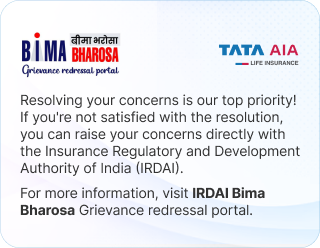13-10-2022 |
When it comes to building long-term wealth, two popular investment options often come up, ULIPs (Unit Linked Insurance Plans) and SIPs (Systematic Investment Plans). Both offer structured ways to grow your funds, but their purposes, benefits, and structures differ significantly. Understanding these differences between these investment avenues can help investors make informed financial decisions that suit their goals and risk appetite. In this article, we will understand what are the benefits of ULIP vs SIP.
What are ULIPs?
Unit-linked insurance plans, or ULIPs, are life insurance policies whereby a part of the premium goes into equities and bonds. You get protection for your family and market-linked returns. A long-term wealth creation tool with tax* benefits, a ULIP policy provides returns on investment and covers your family's needs while you're away.
What are SIPs?
Mutual funds offer Systematic Investment Plans, or SIPs, whereby an individual can invest in a fund in instalments. When you buy an SIP, as an investor, you have an option to decide the amount you want to invest and the time intervals after which you want to make regular investments.
What are differences between ULIP and SIP
The following table highlights the main difference between ULIP and SIP.
Parameter |
ULIP |
SIP |
Nature of investment |
The product combines insurance and investment in a single product. |
Pure investment product, no insurance cover. |
Risk Level |
Varied - Equity/Debt as per the selected fund type. |
Based on mutual fund category and market condition. |
Lock-in Period |
5 years minimum. |
No compulsory lock-in except in ELSS funds. |
Tax Benefits |
Available under Sec 80C and Sec 10(10D). |
ELSS mutual funds enjoy the benefit of deduction available under Sec 80C. |
Returns |
Depends on performance of the fund and policy charges. |
Depends on mutual fund performance only. |
Protection |
Provides life insurance protection. |
No protection of insurance provided. |
These distinctions emphasise the fact that though ULIPs are a dual-benefit product, SIPs focus exclusively on market-linked investment returns. Also, most SIPs invest in equity-oriented funds. When you invest in ULIPs, you can choose between equity, debt, and hybrid fund
What are differences between ULIP and SIP based on tax benefits
Both ULIPs and SIPs provide tax* benefits, but under different conditions. Here's the comparison:
Parameter |
SIP |
ULIP |
Tax Deduction |
Eligible for deduction* up to ₹1.5 lakh under Section 80C (for ELSS). |
Eligible for deduction* up to ₹1.5 lakh under Section 80C. |
Tax on Returns |
Returns are taxed as capital gains depending on the fund type and holding period (equity or debt). |
Returns are treated as capital gains, with taxation based on the investment term and fund type. |
Tax-Free* Returns |
Equity SIPs (ELSS) become tax-free* for long-term capital gains after 3 years. |
ULIPs offer tax-free* maturity benefits after completing a 5-year lock-in period, subject to certain conditions. |
How to calculate the returns on your ULIP and SIP investments
Estimating ULIP and SIP returns requires an understanding of how the returns are calculated.
ULIP Returns:
Returns are calculated on the net asset value of the selected fund and impacted by market performance, management fees of the fund, and mortality fees.
The formula is:
ULIP Return = (Current NAV – Initial NAV) / Initial NAV × 100
SIP Returns:
The XIRR (Extended Internal Rate of Return) method is utilised to compute SIP returns, which takes into consideration the time value of money and regular contributions. Thus, it renders a true picture of gains made throughout the investment phase.
Factors to consider when choosing ULIP and SIP
Before choosing between ULIP and SIP, pay attention to the following major factors that match your financial goals:
Risk Profile
Your ability to handle risk is an important factor in deciding where you invest. ULIPs provide a choice to balance between equity and debt funds andhence may suit moderate to long-term investors looking for balance. SIPs also depend upon your risk tolerance, so consider doing proper research before investing.
Flexibility
ULIPs provide flexibility to adjust your fund allocation between debt and equity as your financial priorities evolve. SIPs are more flexible in terms of ease to start one, pause, or stop them anytime without penalty, which suits investors seeking short-term liquidity.
Objective
If you are aiming for wealth creation as well as protection, ULIPs may suit you. But for achieving capital appreciation alone, SIPs may help.
Return on Investment
ULIP returns are subject to the performance of the funds and charges but become stable for long-term investors because of compounding. SIPs tend to provide competitive market-linked returns, particularly when in equity funds for the long term.
Coverage
ULIPs incorporate a life insurance element, providing your family with financial security during challenging times. SIPs lack coverage, and therefore, a separate life insurance policy may be required.
Cost
ULIPs come with premium allocation and management charges, particularly during the early years, affecting returns slightly. SIPs incur fund management charges but no insurance-related fees, making them cost-effective for short-term investors.
Liquidity
SIPs are more liquid because mutual funds can be withdrawn at any time. ULIPs are locked in for five years, and partial withdrawals are possible thereafter. If liquidity is a concern, SIPs may be suitable.
ULIP vs SIP: Which is Better
Let’s now understand SIP or ULIP, which is better.
Criteria |
ULIP |
SIP |
Includes life insurance |
Offers insurance coverage along with investment. |
Pure investment instrument. |
Main purpose |
Protection and investment combined. |
Regular, disciplined investing. |
Liquidity |
Limited during the lock-in period. |
Generally, more liquid; can be stopped anytime. |
Taxation Benefits |
Eligible under Section 80C - Conditions apply. |
Certain funds offer tax benefits, such as ELSS. |
Best suited for |
Long-term investors seeking insurance + market-linked returns. |
Investors seeking flexible, goal-based wealth creation. |
Making a choice between ULIP and SIP may depend on your personal goals. Ensure that you assess your need for life insurance plans, liquidity, and investment flexibility before deciding.
Conclusion
Both ULIPs and SIPs can be included in a balanced investment plans. While ULIPs provide life cover, disciplined savings, as well as tax effectiveness, SIPs offer flexibility and liquidity, as well as easy access to market-linked growth. By diversifying, you may utilise ULIPs for long-term protection-led goals as well as SIPs for flexible wealth-building. With the proper combination of investment plans, you can achieve financial security with the certainty that your investments work toward your future objectives in a consistent manner.











 FOR EXISTING POLICY
FOR EXISTING POLICY 
 FOR NEW POLICY
FOR NEW POLICY 








